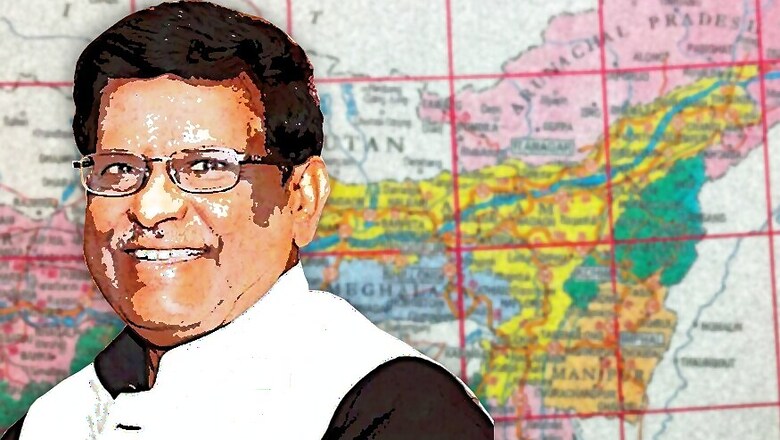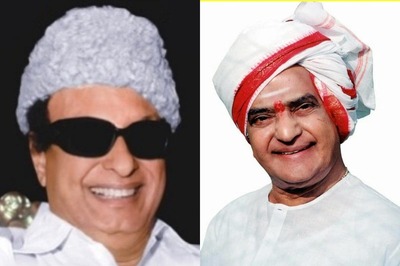
views
 Between July 2014 and May 2015, Mizoram's Raj Bhavan was always bustling with activity, but the state and its 11 lakh citizens hardly had anything to do with it. The hustle and bustle at the Governor's house came from the constant moving in and going out of its occupants. The state saw seven Governors in these 10 months. A new government was sworn in at the Centre and it was time to put its own men in Raj Bhavans across the country. Peaceful Mizoram, thus, became the shunting haven for the new BJP government.
Between July 2014 and May 2015, Mizoram's Raj Bhavan was always bustling with activity, but the state and its 11 lakh citizens hardly had anything to do with it. The hustle and bustle at the Governor's house came from the constant moving in and going out of its occupants. The state saw seven Governors in these 10 months. A new government was sworn in at the Centre and it was time to put its own men in Raj Bhavans across the country. Peaceful Mizoram, thus, became the shunting haven for the new BJP government.
The reason was simple. The state was peaceful and politically stable enough to not require active central monitoring. On the other hand, it was remote enough to be made to look like a punishment posting. A number of Governors were UPA appointees and the government did not want to be seen as sacking them. So Delhi chose to move them to this hill state.
Three-time Delhi chief minister and then Kerala governor Sheila Dikshit resigned from her position in August 2014, when she was shunted to Mizoram. Just days before her resignation, 82-year-old Maharashtra governor K Sankaranarayanan had resigned, refusing to take up the same Mizoram position. But why did the position fall vacant? It fell vacant because the Modi government sacked Kamala Beniwal, just a month after she was shifted here. Probably, the former Gujarat governor had refused to take the hint when she was given the transfer orders.
The position of the Governor in the frontier state of Northeast India was always shrouded in controversy. Explaining the role of the Governor, Pradip Phanjoubam, author of The Northeast Question: Conflicts and Frontiers and editor of Manipur's English daily, Imphal Free Press, refers to Fali Nariman's seminal work in this regard. Pradip says, “It is ironic that the two roles of the Governor as defined in the Constitution are at odds with each other.”
Pradip, who dealt with this issue extensively in his book, explains how the suspicion of the architects of the Constitution over the behaviour of the princely states can be seen on the definition of the role of the Governor. “A young India was suspicious of how the states would behave, especially those in the frontier,” he says.
But the situation has changed over the last 10 years. Insurgency is at its lowest ebb, the militant groups have either been neutralised or brought to the table or there has been a significant fall in their operational power. And this has brought in another dimension to the Governor's office. Pradip Phanjoubam calls it the shift from “retired bureaucrats to unemployed sycophants”.
This lack of cultural assimilation was particularly evident when V Shanmuganathan was made the Governor of Manipur. He drew the ire of the entire intelligentsia when on an August evening at the inauguration of the University of Culture and Manipur State Film and Television Institute, he asked the intellectuals to define ‘culture’ in 100 words. He said in return they could have the “honour” of having tea with him.
Later, award-winning Manipuri filmmaker Aribam Syam Sharma wrote an open letter to him saying: “I shall not attempt an answer to your question here so I forfeit any claim to tea with your excellency.” He went on to say “…in the culture of those assembled on that occasion, asking such a question — fit for school children — to those who have dedicated their lifetime, who are living embodiment of culture, is considered as uncultured in our culture.”
It was then that he was moved to Meghalaya, where the popular mutiny against him for allegedly “converting the Raj Bhavan into a ladies’ club”, forced the central government to ask for his resignation. It is debatable whether the government would have acted so promptly if there were no state elections around the corner.
It is not just him. The fiefdom of Tripura has been gifted to the loyal soldier of the Sangh in Bengal. Tathagata Roy, BJP leader from West Bengal, is known for his infamous and often communal tweets. Before he became the Governor, he had once tweeted: “I sometimes think how lucky I am, that I am nearly 70 and won’t live to see the Islamic takeover of West Bengal (sic).” While such direct attacks have stopped, his tweets continue to have deep communal overtones. Recently, he retweeted this post: “Dear Hindus Let's unite n come out to vote for Modi otherwise we will not get another @narendramodi to save us frm Malecha (sic).”
It is because of these incidents that many think the position of the Governor has become redundant. Kishalay Bhattacharjee, author and a senior journalist from the Northeast says, “Throwing out Meghalaya and Arunachal Pradesh Governor by staff shows that all is not lost. Now we need a sustained campaign to do away with the office of the Governor.” But there are those who point out that India, which is ultimately a union of states, needs a representative of the Centre in each of the states to maintain the federal structure.




















Comments
0 comment